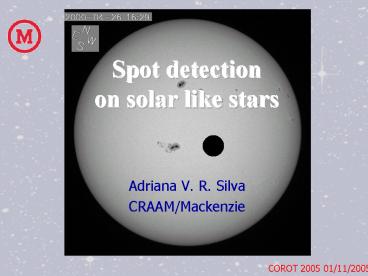Spot detection on solar like stars - PowerPoint PPT Presentation
Title:
Spot detection on solar like stars
Description:
Currently it is not possible to detect, let alone monitor the behavior of solar ... during the planetary transit caused by the planet occultation of starspots. ... – PowerPoint PPT presentation
Number of Views:41
Avg rating:3.0/5.0
Title: Spot detection on solar like stars
1
Spot detection on solar like stars
- Adriana V. R. Silva
- CRAAM/Mackenzie
COROT 2005 01/11/2005
2
Sunspots
- Regions of high concentration of magnetic fields
- Indicators of magnetic activity cycle
- Understanding of solar activity
- solar flares, coronal mass ejections, etc
- Currently it is not possible to detect, let alone
monitor the behavior of solar like spots on other
stars due to their very small sizes.
3
Transits
- Mercury transit on November 15, 1999, that
lasted about 1 hour.
4
Goal of accepted AP
- During one of its transits, an exoplanet may pass
in front of a stellar group of spots. - A method for studying the physical
characteristics of starspots based on planet-ary
transits is proposed. - Observations of HD 209458 are used to test the
model. - Silva, ApJ Letters, 585, L147-L150, 2003.
5
Extra-solar planets
- 169 planets detected presently.
- 9 transiting HD 209458, TrES-1, OGLE-10, 56,
111, 113, 132, HD 189733, HD 149026. - Data from HD 209458
- April 25, 2000 (Brown et al. 2001) with the
Hubble Space Telescope (HST) - July 26, 2000 (Deeg et al. 2001) with the 0.9
telescope of the Observatorio Sierra Nevada.
6
Data
- Two observations with bumps in the light curve
were used - Deeg et al. (2001) Brown et al. (2001)
- HST
7
Model
- Star ? white light image of the Sun
- Planet ? opaque disk of radius r/Rs
- Transit at each time the planet is centered at a
given position in its orbit (aorb/Rs and i) ?
calculate the integrated flux - Search in parameter space for the best values of
r /Rs, aorb /Rs, and i (minimum ?2)
8
Transit Simulation
9
HD 209458 transit
- Planet in a circular orbit around HD 209458 with
a period of 3.5247 days, major semi-axis of
0.0467 AU, and inclination angle, i86,68. - Planet radius 1.347 RJup, and stellar radius
1.146 RSun. - The planet is represented by an opaque disk that
crosses the stellar disk at 30.45 latitude
(corresponding to i86,68). - The planet position is calculated every two
minutes. - Lightcurve intensity at every two minutes is the
sum of all the pixels values in the image.
10
Spot parameters
- The spots were modeled by three parameters
- Intensity, as a function of stellar intensity at
disk center (max) - Size, as a function of planet radius
- Position, as a distance to the transit line in
units of planet radius.
11
HD209458 (Deeg et al. 2001)
12
Limb darkening
quadratic
- HST data (Brown et al. 2001) is not well fit by
the model, indicating that the limb darkening of
HD209458 is not a linear function of ?, as that
of the Sun, instead it is best described by a
quadratic function (?cos?).
linear
13
Model star
- Star represented by a quadratic limb darkening
with w10.2925 and w20.3475 (Brown et al. 2001). - Spot modeled by three parameters
- Intensity, as a function of stellar intensity at
disk center (max) - Size, as a function of planet radius
- Position, as a distance to the transit line in
units of planet radius.
14
HD209458 (Brown et al. 2001)
15
Results
Rp9.4 104 km
- Starspot temperature, T0, estimated from
blackbody emission, where Te is the stellar
surface temperature assumed to be 600050 K
(Mazeh et al. 2000) - Starspot temperatures between 4900-5000 K.
16
Conclusions
- This method enables us to estimate the starspots
physical parameters. - From modeling HD208458 data, we obtained the
starspots characteristics - sizes of 3-6 104 km, being larger than regular
sunspots, usually of the order of 11000 km
(probably a group of starspots, similar to solar
active regions). - temperatures of 4900 - 5500 K, being hotter than
regular sunspots (3800-4400K), however the
surface temperature of HD 209458, 6000K, is also
hotter than that of the Sun (5780K).
Nevertheless, the sunspots seen in the white
light image are also about 0.4-0.7 of the solar
disk center intensity, similarly to what was
obtained from the model. - Location latitude.
17
CoRoTobservational requirements,feasability,
andexpectations
18
Simulation results
- Small variations in the lightcurve during the
planetary transit caused by the planet
occultation of starspots. - Uncertainty of 0.0001 in flux.
Relative flux
Jupiter size Planet
Relative flux
1.5 Earth size Planet
phase
19
Stellar rotation
26 April 2000
29 April 2000
starspot
20
Rotation period
- Subtracting the lightcurve taken 3 days later,
measure the ?f between the starspot position. - Rotation period of the star
- Ps27.6 days
21
Summary
- Core programme data
- Observations of planetary transits with
- ?I/I0.0001
- Temporal resolution of few minutes
- Results expected
- Starspot characteristics (size, temperature,
location, evolution) - Starspot structure for Earth size planets
- Limb darkening ? temperature gradient of the
stellar photosphere - Stellar rotation (solar-like stars 150 days 5
periods) - Extra
- Differential rotation (planets at different
latitudes) - Activity cycles (for short cycles)































